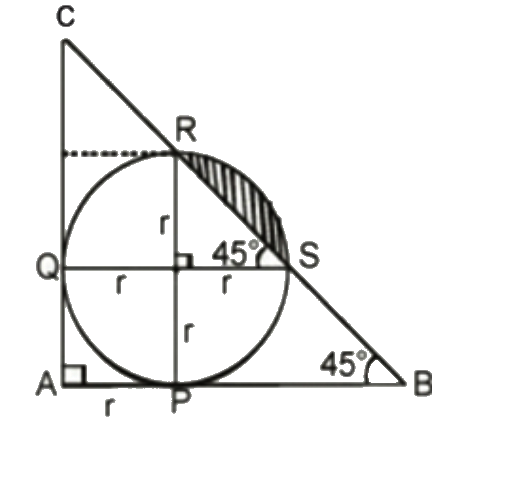In a right triangle ABC, a circle with AB as diameter is drawn to intersect the hypotenuse AC in P. Prove that the tangent at P, bisects the side BC.
The correct Answer is:CQ=BQ
To solve the problem, we will follow a structured approach to prove that the tangent at point P bisects the side BC in triangle ABC.
1. Understanding the Setup:
- We have a right triangle ABC with the right angle at C.
- A circle is drawn with diameter AB, which intersects the hypotenuse AC at point P.
2. Drawing the Tangent:
- At point P, draw a tangent line PQ to the circle. We need to prove that this tangent bisects the side BC, meaning we need to show that BQ = QC.
3. Using the Property of Tangents:
- From point Q (the external point), we know that the lengths of the tangents drawn from an external point to a circle are equal. Thus, we have:
PQ=BQ
4. Analyzing the Angles:
- Since AB is the diameter of the circle, by the property of circles, angle APB is 90 degrees (angle subtended by a diameter).
- Therefore, angle BPC is also 90 degrees (since angles on a straight line sum up to 180 degrees).
5. Examining Triangle BPC:
- In triangle BPC, we have:
∠BPC=90∘
- This means that:
∠BPQ+∠CPQ=90∘
6. Using Triangle Properties:
- In triangle PBC, we can apply the angle sum property:
∠PBC+∠PCB+∠BPC=180∘
- Since ∠BPC=90∘, we have:
∠PBC+∠PCB=90∘
7. Establishing Angle Relationships:
- We know that:
∠PBC=∠PBQand∠PCB=∠PCQ
- Therefore, we can substitute:
∠PBQ+∠PCQ=90∘
8. Equating Angles:
- Since we established that both pairs of angles sum to 90 degrees, we can equate them:
∠BPQ+∠CPQ=∠PBC+∠PCB
- This leads us to conclude that:
∠CPQ=∠PCB
9. Concluding the Proof:
- Since ∠CPQ=∠PCB and PQ=BQ, by the properties of triangles, we can conclude that:
QC=BQ
- Thus, the tangent PQ bisects BC, proving that:
BQ=QC
Final Result:
The tangent at point P bisects the side BC in triangle ABC.
---
- We have a right triangle ABC with the right angle at C.
- A circle is drawn with diameter AB, which intersects the hypotenuse AC at point P.
- At point P, draw a tangent line PQ to the circle. We need to prove that this tangent bisects the side BC, meaning we need to show that BQ = QC.
- From point Q (the external point), we know that the lengths of the tangents drawn from an external point to a circle are equal. Thus, we have:
PQ=BQ
- Since AB is the diameter of the circle, by the property of circles, angle APB is 90 degrees (angle subtended by a diameter).
- Therefore, angle BPC is also 90 degrees (since angles on a straight line sum up to 180 degrees).
- In triangle BPC, we have:
∠BPC=90∘
- This means that:
∠BPQ+∠CPQ=90∘
- In triangle PBC, we can apply the angle sum property:
∠PBC+∠PCB+∠BPC=180∘
- Since ∠BPC=90∘, we have:
∠PBC+∠PCB=90∘
- We know that:
∠PBC=∠PBQand∠PCB=∠PCQ
- Therefore, we can substitute:
∠PBQ+∠PCQ=90∘
- Since we established that both pairs of angles sum to 90 degrees, we can equate them:
∠BPQ+∠CPQ=∠PBC+∠PCB
- This leads us to conclude that:
∠CPQ=∠PCB
- Since ∠CPQ=∠PCB and PQ=BQ, by the properties of triangles, we can conclude that:
QC=BQ
- Thus, the tangent PQ bisects BC, proving that:
BQ=QC
The tangent at point P bisects the side BC in triangle ABC.
Topper's Solved these Questions
- TANGENTS AND INTERSECTING CHORDSBOOK - ICSECHAPTER - TANGENTS AND INTERSECTING CHORDSEXERCISE - EXERCISE 18(A)
24 Videos
- TANGENTS AND INTERSECTING CHORDSBOOK - ICSECHAPTER - TANGENTS AND INTERSECTING CHORDSEXERCISE - EXERCISE 18 (B)
18 Videos
- SPECIMEN QUESTION PAPER (MATHEMATICS)BOOK - ICSECHAPTER - SPECIMEN QUESTION PAPER (MATHEMATICS)EXERCISE - Section C
12 Videos
- TRIGONOMETRICAL IDENTITIESBOOK - ICSECHAPTER - TRIGONOMETRICAL IDENTITIESEXERCISE - QUESTIONS
22 Videos
Similar Questions
In a right angle triangle ΔABC is which ∠B=90∘ a circle is drawn with AB diameter intersecting the hypotenuse AC at P.Prove that the tangent to the circle at PQ bisects BC.
View SolutionIn a right angled triangle with sides a and b and hypotenuse c , the altitude drawn on the hypotenuse is x . Prove that ab=cx .
View Solution
Knowledge Check
In right triangle, ABC, AB=10,BC=8,AC=6.
A35B34C45D54
ABC is a right triagle with angle B=90∘ . A circle with BC as diameter meets hypotenuse AC and point D. Prove that
(i) AC×AD=AB2
(ii) BD2=AD×DC
View SolutionIn a triangle ABC , let P and Q be points on AB and AC respectively such that PQ∣∣BC . Prove that the median AD bisects PQ.
View SolutionABC is a triangle A line is drawn parallel to BC to meet AB and AC in D and E respectively. Prove that the median through A bisects DE.
View SolutionIn a right triangle ABC, right angled at A, AD is drawn perpendicular to BC. Prove that:
AB2−BD2=AC2−CD2
View SolutionIn trapezium ABCD, side AB is parallel to side DC. Diagonals AC and BD intersect at point P. Prove that triangles APD and BPC are equal in area.
View SolutionΔABC is a right triangle right angled at A such that AB=AC and bisector of ∠C intersects the side AB at D. Prove that AC+AD=BC.
View SolutionABC is a right triangle, right - angled at the vertex A. A circle is drawn to touch the sides AB and AC at points P and Q respectively such that the other end points of the diameters passing through P and Q lie on the side BC. IF AB = 6 units, then the area (in sq. units) of the circular sector which lies inside the triangle is

View Solution
